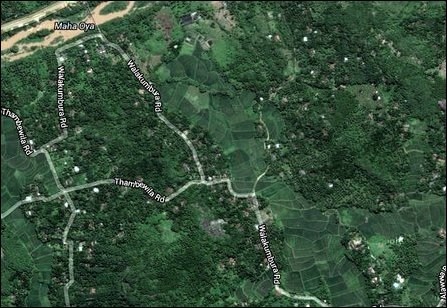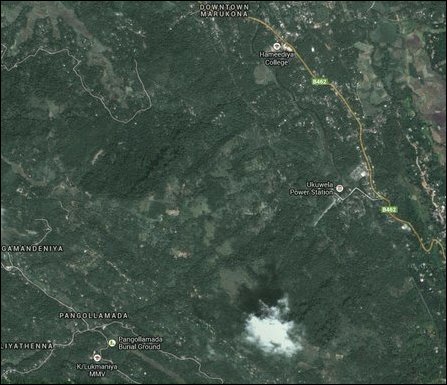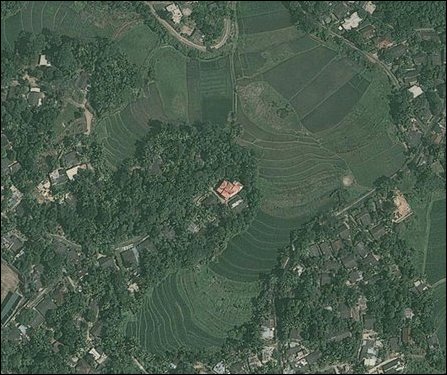Know the Etymology: 289
Place Name of the Day: Thursday, 19 September 2013
Hela-mada
ஹெலமட3
HelamaḍaHela+mada
The muddy tract or cultivation beds at the slope of the hill
| Hela |
Hillock, declivity (Sinhala, Clough); Escarpment (Sinhala, Madduma Bandara, 2009); Hæla-lihinyaa: Also Sæla-lihiniyaa: Hill mina; Helanawaa: To throw, to cast, to drop, to cause to fall (Sinhala); 1. Saila: Made of stone, rocky, rock, hill (Sanskrit, CDIAL 12616); Sela: Rocky, rock, crystal (Pali, Prakrit CDIAL 12616); Sella: Collection of stones (Prakrit, CDIAL 12616); Sel: Rock, stone, mountain (Sinhala); Chilampu: Hill, side of hill (Tamil, Changkam Diction); 2. Chaaral: Slope of Mountain (Tamil, DED 2460); from the root Chaar: leaning against, inclination, side, declivity of hill (Malayalam, DED 2460); Chari: (verb) To slide down, roll, tumble, stumble down, incline, slope; (noun) declivity, slope of a mountain (Tamil, DED 2360); Charivu: Sliding, slipping down, slope, declivity (Tamil, DED 2360); Charuvu: Declivity, steep side of a rock (Tamil, DED 2360); Sari: Precipice, deep ravine (Kannada, DED 2360); Cari: Cliff, precipice, side of a hill or mountain (Telugu, DED 2360)
|
| Mada |
Mud, slime (Sinhala); Lowland cultivation (Sinhala, Madduma Bandara, 2009); Mada-bima: Muddy place, sink, bog, swamp; also a place prepared for the sowing of paddy by trampling it with oxen (Sinhala); Mada-wanawaa: To make the ground soft and muddy by trampling it with oxen prior to the sowing of the rice (Sinhala); Maditta: Muddy ground, slough, bog (Sinhala); Mada-badda: Tax on paddy land (Sinhala); Manda: Dregs, dross, lees (Sinhala); Mandi: Sediment, dregs, settlings (Tamil, DED 4676); Maddi: Sediments (Tulu, Kannada, DED 4676); Mandu: (verb) to form as a layer of sediments (Tamil, related to DED 4681); Vandal: Dregs, lees, sediment, silt, mud, mire, slush, earth washed ashore by a river, lake, etc., alluvial soil (Tamil, DED 5237); Vandu: Muddy deposits, muddiness (Kannada, DED 5237); Vanda: Muddy deposit, alluvium, alluvial soil (Telugu, DED 5237). Also see columns on Maddak-kalappu and Mandu-kuvinthaan.
|

Helamada, the paddy field beds on the drainage slope of a hill reach the river Maha-oya. [Image courtesy: Google Earth]
Mada is a popular place name component in Sinhala.
The dictionary meanings for the word Mada are mud and slime. Maditta means a muddy ground, slough or bog.
However, in Sinhala phrases, the word Mada is seen connected to a paddy field. Mada-bima is a muddy place as well as a place prepared for the sowing of paddy (bima means earth). Mada-wanawaa as a verb phrase means making a ground muddy to sow paddy. Mada-badda is a tax on paddy land.
Mada originally meaning mud became a word for a paddy field too, as paddy fields are muddy tracts of land.
Mada specifically means lowland cultivation, notes Prof Madduma Bandara (2009).
A scrutiny of Sinhala places having the component Mada in their names shows that such places are either associated with muddy tracts, or with muddy tracts converted into paddy fields. Most of them are now paddy fields and a majority of the place-name examples are found in the hill country districts, suggesting that the term Mada is largely preferred for cultivation beds getting natural irrigation, such as hill slopes, water-stagnant areas etc.
Mada, in its primary sense of meaning, i.e., mud, is related to Manda in Sinhala, meaning sediments, deposits etc., and to Dravidian cognates such as Mandi in Tamil and Maddi in Tulu/ Kannada, meaning the same (DED 4676). The verb form Mandu in Tamil/ Dravidian means sediments settling densely (DED 4681).
Another set of cognates in Dravidian could be seen in words such as Vandal in Tamil, Vandu in Kannada and Vanda in Telugu, meaning alluvium or alluvial soil (DED 5237).

Marahela, literally meaning the escarpment of death, is a village at the bottom of the steep escarpment where the Ukuwela hydropower station is located. Also note the place name Pan-golla-mada. [Image courtesy: Google Earth]
Two shades of meanings are found for the word Hela in Sinhala: one is a hillock and the other is declivity (Clough).
In the sense of a hillock, Hela is related to another Sinhala word, Sel, meaning rock, stone or mountain. Both are Indo-Aryan cognates of Saila and Sela in Sanskrit and Pali/ Prakrit respectively, meaning rock or hill (CDIAL 12616).
In the sense of declivity, Hela in Sinhala is related to the verb form helanawaa in Sinhala, meaning to throw, to cast, to drop or to cause to fall. In this sense of meaning, Hela seems to be related to the Tamil/ Dravidian word Chari, which as a verb means to slide down and as a noun means declivity and slope of a mountain (DED 2360).
The other related words are Charivu, Cari and Sari in Tamil, Telugu and Kannada respectively, meaning declivity, cliff, precipice, deep ravine, sloping side of a hill etc. (Note the C/ S > H and R > L changes between Cari/ Sari and Hela)
Another set of cognates in Dravidian is related to the root Chaar (leaning). Chaaral in Tamil and Chaar in Malayalam, meaning slope of a hill are two examples (DED 2460).
Hela in the context of Sinhala place names means an escarpment, notes Prof Madduma Bandara (2009). Most of the places having the component in the names are escarpments, high or low. Some of the best-known steep and high escarpments in the island are associated with the term Hela (see related place names).
* * *Hela-mada is in Galigamuwa division of Kegalle district. The place is seen with step paddy fields on the slope of an escarpment.

Morahela is a village in Ratnapura district at the bottom of the steep escarpment of Horton Plains. [Image courtesy: Google Earth]
The great, difficult or arduous escarpment; Siyambalanduwa division, Ampaarai district. There is a steep and forested escarpment at this place.
Mora-hela: The escarpment of mora trees or the swamp of mora trees: Impulpe division, Meegaha ´kivula division, Badulla district; Ratnapura district; Walapane division, Nuwara Eliya district. Marahela of Ratnapura district is in a swamp but it overlooks the steep escarpment of Bogawanthalawa within a distance of 4 km.
Mara-hela: The escarpment of death or the swamp of death; Akurana division, Kandy district. The place in is a swampy area, but at the bottom of the steep escarpment of the Ukuwela Hydropower Station.
Hela-kadurugamuwa: The village of Kaduru trees located at the escarpment; Haputale division, Badulla district. The place is located at the edge of a steep escarpment
Kana-hela: The forest escarpment; Passara division, Badulla district
Hela-gam-pura: The settlement of the escarpment village; Damana division, Ampaarai district. With the pura suffix the place name seems to be a new one. There is an escarpment or spur of a hill. At the bottom there is a tank called Malaiyadi kulam, meaning the tank at the bottom of the hill. The village was long known as Malaiyadik kiraamam (the village at the bottom of the hill) in Tamil.
Berali-hela: The declivity having Beraliya trees; Lunugamvehera division, Hambantota district. The place has a hillock and a range of a very low escarpment or declivity in the landscape

The step beds of paddy fields at Maavilmada, ending up in a flat spot that was probably a marsh before. [Image courtesy: Google Earth]
The side of cultivation fields or the muddy side; Kesbewa division, Colombo district
Mada-wala: The muddy forest or the forest having cultivation fields; Katana division, Gampaha district; Muthugama division, Kalutara district; Pathadumbara division, Kandy district; Weerambugedera division, Kurunegala district; Palugaswewa division, Anuradhapura district
Kalu-mada: The dark mud or the cultivation fields in the dark earth; Divulapitiya division, Gampaha district
Pal-mada: The cultivation fields in the muddy area; Mirigama division, Gampaha district
Mada-kotuwa: The enclosure in the cultivation beds or the cultivation beds having an enclosure; Attanagala division, Gampaha district
Mada-bavita: The cultivation fields obtained or habituated; Mirigama division, Gampaha district. Baavitaa, Bhaavitaa: obtained, got, habituated (Sinhala)
Mada-deniya: The rising land of cultivation fields; Poojapitiya division, Kandy district; Yatawatta division, Matale district
Pan-golla-mada: The cultivation fields or muddy area of the Pan grass jungle; Akurana division, Kandy district
Gedara-mada: The cultivation fields having a house premises; Udadumbara division, Kandy district
Mada-pola: The open space of cultivation fields or a muddy place; Medadumbara division, Kandy district
Mada-kumbura: The paddy fields in the muddy area: Rattota division, Matara district; Kothmale division, Nuwara-Eliya district; Karandeniya division, Galle district
Kalinga-mada: Probably, the cultivation fields irrigated by a sluice; Ukuwela division, Matale district. Kalingku: Sluice or water-weirs for surplus vents (Tamil, DED 1309). The term is used in Eezham Tamil. There is another place Kalingu-ela, meaning the rivulet flows from the sluice or spill, in Thamankaduwa division, Polonnaruwa district
Maavil-mada: The cultivation fields of the big pond or marsh; KFG&G Korale division, Kandy district
Enasal-mada: The cultivation field or the muddy place of cardamom; Ukuwela division, Matale district. Ensaal: Ceylon cardamoms, Elettaria cardomomum (Sinhala)
Mada-baddara: The tax-paying paddy land; Ayagama division, Ratnapura district
Weli-mada: The cultivation fields in the sandy or gravelly area; Welimada division, Badulla district
First published: Thursday, 19 September 2013, 21:54
Previous columns:










